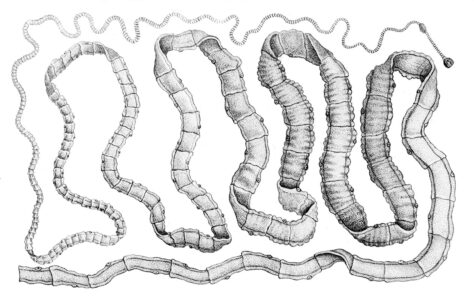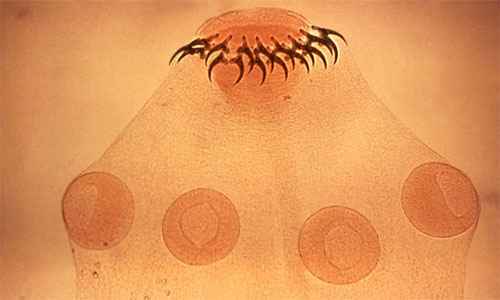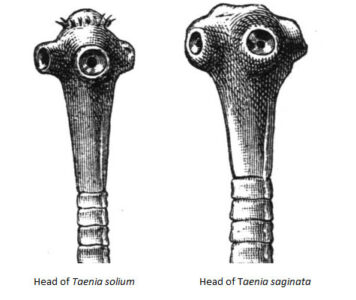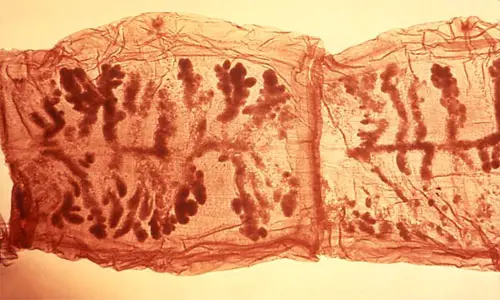Cestodes or tapeworms are the members of the class Cestoda of the phylum Platyhelminthes. About 6000 species of cestodes are identified as parasites and they are mainly intestinal. They are both marine and terrestrial; vertebrates are the definitive hosts and their intermediate hosts are crustaceans, insects, annelids, mollusks, etc.
The species T. saginata (beef tapeworm) can grow up to 65 ft (20m) in length while the largest tapeworm, known as the whale tapeworm (Tetragonoporus calyptocephalus) can grow up to 100 ft (30 m) or more. Besides these, the smallest parasite, known as vole and lemming tapeworms, can grow up to only 13–240 mm in length.

Taenia solium: Image credit-Wikimedia Commons
Among the cestode species, Taenia solium, Taenia saginatum, Hymenolepis nana and Diphyllobothrium latum are the most common parasite of human.
Classification of Cestodes
According to Habitat, the cestodes are the following types:
A. Intestinal Tapeworms: Adults live in intestine of human.
- Taenia saginata (Beef tapeworm)
- Taenia solium (Pork tapeworm)
- Hymenolepis nana (Dwarf tapeworm)
- Hymenolepis diminuta ( Rat tapeworm)
- Diphylobothrium latum (Fish tapeworm)
- Diphylidium carinum (Double-pored Dog tapeworm)
B. Tissue Tapeworms-Larval Stage
- Hydatid cyst of Echinococcus granulosus (Dog tapeworm), E. multilocularis
- Cysticercus cellulose of Taenia solium.
- Coenurus cerebralis of Multiceps multiceps.
- Plerocercoid of Sparganum mansoni and Sparganum proliferum.
General Characteristics of Cestodes
1. Adult Cestodes: Adult cestodes have tape-like, ribbon shaped and segmented body and the length varies from few mm to several meters. They are flattened dorso-ventrally. An adult worm has three regions:
- Head or Scolex
- Neck and
- Strobila (a trunk or body) consisting of proglottid or segments.

Scolex of Taenia solium: Image credit-Wikimedia Commons
Head is provided with attachments. Rostellum is a beak-like projection on the head which carries hooklets.

Image Credit: Wikimedia Commons
2. Proglottid or Segnments: Each proglottid or segment is essentially a functional individual, i.e. a complete unit of a tapeworm. A segment is called immature if the male and female reproductive organs are not differentiated, mature if the reproductive organs are differentiated and gravid if the uterus is filled with eggs. These are seen from front to backwards.

Progloyid of Cestode (Taenia solium): Image credit: wikimedia commons
3. Mouth, alimentary and body cavity are absent. Glucose or other simple nutrients are absorbed directly from the host gut.
4. Excretory and nervous systems are present.
5. Reproductive system: Each worm is a hermaphrodite, i.e. sexes are separate.
(a) Male genital system: It lies on the dorsal surface of each segment and mature before the female genital system. It consists of testes, vas deferens and cirus(penis). The cirus and vagina open into a common genital pore which is on the mid-ventral surface in Pseudollidea and on the lateral border in Cyclophylidea.
(b) Female genital system: It lies on the ventral surface and consists of ovary (single or paired), vagina from genital pore to ootype, uterus which is open in Pseudophyllidea and a blind sac in Cyclophyllidea and Ootype where ovum is fertilized.
6. Fertilization: It takes place between the segments. It may be a self-fertilization or a cross-fertilization between the segments of same or other worm.
7. Eggs: Eggs are formed in ootype and are present in large numbers in gravid segments. An egg may be:
(a) Operculated has a ciliated epithelium or
(b) Non-operculated in Cyclophyllidea. It has two coverings-outer egg-shell and inner embryophore which surrounds the embryo. The formed embryo is a six hooked (hexacanth) sphere called oncosphere or hexacanth embryo. The space between the embryophore and the eggs shell contains yolk material.
8. Larva: The following types of larvae are found in cestodes:
(a) Cysticercus: The entire larva is transformed into a bladder from which the head or scolex of the worm sprouts. One adult worm develops from each scolex. This consists of a bladder with one scolex as in Taenia saginata and Taenia solium.
(b) Hydatid cyst: This is the cystic larval form. A bladder multiplies through the process of budding and produces many bladders. On the wall of these cysts, brood capsules are produced, inside which the scolices as in Enterococcus granulosus.
(c) Cysticercoid: The entire larva is solid containing a scolex, e.g. in Hymenolepis nana.
(d) Plerocercoid and procercoid are found in fish tapeworm.
Economic Importance of Cestodes
The most of the tapeworms are the harmful organisms. They are the parasitic worms and they are found in the intestine of human(adult form) and cattle(larval forms). Both the tapeworms and bladderworms contribute to loss of meat production of cattle throughout the world. Besides these, they have a few economic importances. In some cases, the tapeworms act as natural fertilizing agent and help to increase the fertility of the soil.
